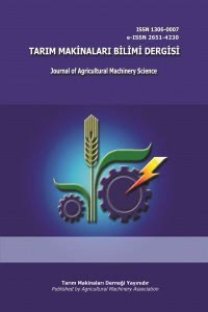An Optimization Study on Corn Silage Mechanization in Ege University Agricultural Research Farm
Corn silage mechanization, optimization, quality silage
___
- ASAE Standards, 48th Ed., 2001. S358.2. Moisture measurement-forages, St. Joseph, Mich:ASAE.
- Borowski, P., 2013. Adaptation strategy of the energy companies to the energy sector policy and regulations in the sustainable development context, International Journal of Engineering and Innovative Technology (IJEIT), Volume 3, Issue 1, pages 1-5.
- Borowski, P., 2011. ‘Transportation development towards the energy independence and CO2 reduction’, Proceeding of International Energy Jordan Conference, Amman, Jordan.
- Harrigan, T.M., 2003. Time-Motion Analysis of Corn Silage Harvest Systems, Applied Engineering in Agriculture, ASAE ISSN 0883-8542, Vol. 19(4): 389-395.
- Klimkiewicz, M., R. Mruk, J. Słoma and J. Wojdalski 2013. The use of raw rapeseed oil to power the engines of agricultural tractors and vehicles, Trends in agricultural engineering 2013, 5th international conference TAE 2013, 3-6 September, 2013 Prague, Czech Republic, pages 330-334.
- Ruppel, K. A., R. E. Pitt, L. E. Chase and D. M. Dalton, 1995. Bunker silo management and its relationship to forage preservation on dairy farms, J. Dairy Sci., 78(1):205-216. Tyson, J. T., R. E. Graves and D. R. Buckmaster, 1996.
- Horizontal silos, fact sheet H 76, University park, Pa: Pennsylvania State University.
- Srivastava, A. K., C. E. Goering, R. P. Rohrbach and D. R. Buckmaster, 2006. Engineering Principles of Agricultural Machines, 2nd ed. St. Joseph, Mich: ASABE.
- ISSN: 1306-0007
- Başlangıç: 2005
- Yayıncı: Tarım Makinaları Derneği
Mikrodenetleyici Kontrollü Balya Sayacı Tasarımı
Aspir Biyodizelinde Farklı Enjektör Basınçlarının Motor Performansına Etkisi
Hüseyin ÖĞÜT, Hidayet OĞUZ, Fatih AYDIN
Tarım Traktörlerinin 2006/42/AT Makine Direktifine Göre Değerlendirilmesi
Hakan VELİOĞLU, Hamdi TAŞBAŞ, Hasan SİLLELİ, Mustafa KANTAŞ, Selçuk OLUM
Traktör Performans Testlerinde Evaporatif Soğutma Sisteminin Ortam Sıcaklığı Üzerine Etkisi
Hasan SİLLELİ, Halil KARKİN, Kamil CAN
Kablosuz Sensör Ağı Teknolojisi ve Hassas Tarım Uygulamaları İçin Örnek Bir Model
An Optimization Study on Corn Silage Mechanization in Ege University Agricultural Research Farm
Mehmet EVRENOSOĞLU, Konuralp ELİÇİN, Piotr BOROWSKİ, Caner KOÇ, Mustafa GEZİCİ, Recai GÜRHAN
Seralar İçin Bluetooth Tabanlı Kablosuz Ölçüm Sisteminin Tasarımı: Prototip Geliştirme ve Uygulama
Mobil Güneş Pili Sulama Makinasının Arazi Koşullarında Bazı Deneysel Çalışmaları
Ümran ATAY, Yusuf IŞIKER, Bülent YEŞİLATA, Ali BAŞÇETİNÇELİK
